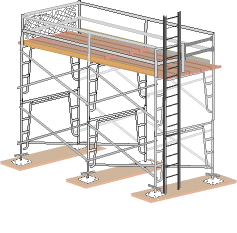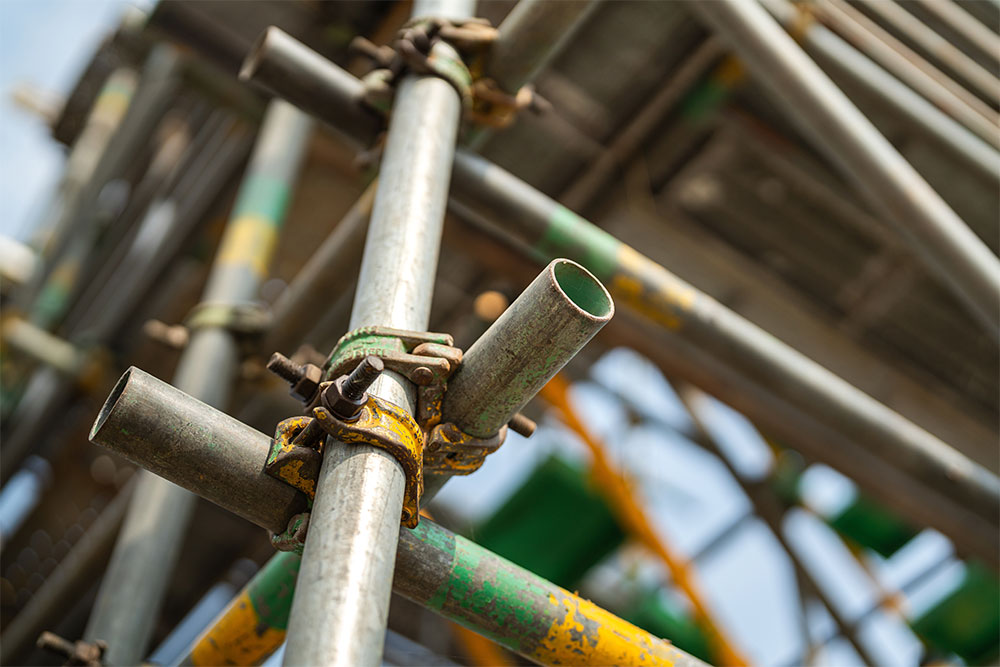Dependable Domestic Scaffolding for Homeowners in Need of Safe Renovations
Dependable Domestic Scaffolding for Homeowners in Need of Safe Renovations
Blog Article
Discovering the Numerous Sorts Of Scaffolding Used in Building And Construction Tasks
The building and construction market relies heavily on numerous types of scaffolding to fulfill specific project needs, each offering unique advantages and applications. Typical framework scaffolding offers a tough foundation for basic jobs, while suspended scaffolding is vital for work on skyscraper structures.

Conventional Framework Scaffolding
Typical structure scaffolding is among one of the most commonly used methods in the building and construction industry as a result of its robustness and convenience. This system is composed of straight and vertical frameworks that are assembled to create a secure platform for employees and materials. The primary elements include upright blog posts, horizontal journals, and angled braces, which with each other give a strong structure that can sustain substantial lots.
Among the essential advantages of conventional frame scaffolding is its versatility to different building and construction projects, varying from domestic structures to big industrial frameworks. The modular style permits simple assembly and disassembly, making it reliable for both short-term and lasting projects. Furthermore, the system can be tailored in height and width, fitting different structure layouts and website problems.
Security is extremely important in scaffolding applications, and conventional structure systems are outfitted with guardrails and toe boards to avoid drops and guarantee worker protection. Furthermore, normal evaluations and adherence to security laws are vital in maintaining the stability of the scaffold. Generally, typical framework scaffolding remains a basic option in the building sector, supplying a dependable platform for labor and boosting overall project effectiveness

Suspended Scaffolding
Put on hold scaffolding uses a special service for construction jobs that require access to raised surfaces, especially in circumstances where standard framework scaffolding might be not practical. This sort of scaffolding is commonly put on hold from the roof or upper degrees of a structure, using a system of platforms, wheels, and ropes to develop a working space that can be changed to different heights.
Among the primary benefits of put on hold scaffolding is its adaptability. It can be quickly repositioned or reduced to accommodate changes in building and construction demands, making it perfect for tasks such as home window setup, façade job, and upkeep on high-rise buildings. Furthermore, the very little footprint of suspended scaffolding allows for much better usage of ground space in metropolitan environments, where room is typically minimal.
Security is an essential factor to consider in the usage of put on hold scaffolding. On the whole, put on hold scaffolding gives a reliable and efficient service for accessing hard-to-reach areas in various construction situations, improving both efficiency and safety and security have a peek here on website.
System Scaffolding
System scaffolding, commonly considered a modern service in the scaffolding sector, contains pre-engineered parts that can be promptly assembled and adjusted for different building tasks. Scaffolding. This sort of scaffolding is characterized by its modular style, which enables for flexibility and performance on task sites, fitting various heights and structural needs
Generally made from high-strength steel or aluminum, system scaffolding provides boosted longevity and stability. The components consist of upright messages, horizontal journals, and angled braces, which interconnect firmly, guaranteeing a robust framework. The design frequently incorporates standardized installations, simplifying setting up and disassembly processes, thereby reducing labor time and prices.

Rolling Scaffolding
Moving scaffolding is a flexible option to standard set scaffolding, created for flexibility and convenience of usage on building and construction sites. This sort of scaffolding contains a platform sustained by frames with wheels, permitting employees to quickly transfer it as needed. The movement function considerably boosts efficiency, as it lessens downtime related to disassembling and putting together repaired scaffolding.
Generally constructed from lightweight materials such as aluminum or steel, rolling scaffolding supplies a strong yet mobile option for jobs requiring constant repositioning - Scaffolding. It is especially useful in jobs such as painting, drywall installment, and electrical job, where access to various elevations and areas is essential
Safety and security is critical in rolling scaffolding design, with attributes such as securing wheels to stop unplanned movement when in operation, and guardrails to secure employees from falls. In addition, numerous versions are adjustable in height, fitting various job requirements.
Cantilever Scaffolding

The layout of cantilever scaffolding typically includes utilizing braces or arms anchored to a building or structure, enabling the system to expand external safely. Safety is paramount; hence, these scaffolds must click resources be crafted to stand up to environmental problems and different loads. Regular inspection and upkeep are vital to make sure structural stability and employee safety.
Cantilever scaffolding is preferred for its convenience and reliable usage of space, making it a preferred option in metropolitan environments where room restrictions are common. Additionally, it promotes less complicated access to high elevations, inevitably contributing to the overall efficiency of building jobs. As with all scaffolding types, appropriate training and adherence to safety and security requirements are essential for employees utilizing cantilever scaffolding.
Final Thought
Standard frame scaffolding provides stability, while put on hold scaffolding uses versatility for elevated jobs. System scaffolding promotes fast assembly, and rolling scaffolding enhances movement for varying work environments.
Conventional frame scaffolding provides a sturdy structure for basic jobs, while put on hold scaffolding is essential for job on high-rise structures.Rolling scaffolding is a versatile choice to typical fixed scaffolding, designed for mobility and convenience of usage on building websites. As with all scaffolding kinds, appropriate training and adherence to safety standards are important for employees using cantilever scaffolding.
Conventional frame scaffolding provides stability, while put on hold scaffolding uses adaptability for elevated jobs. System scaffolding promotes quick assembly, and rolling scaffolding boosts movement for differing job atmospheres.
Report this page